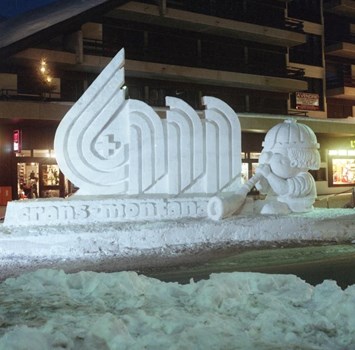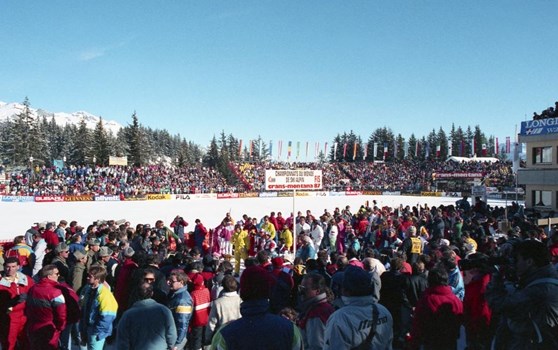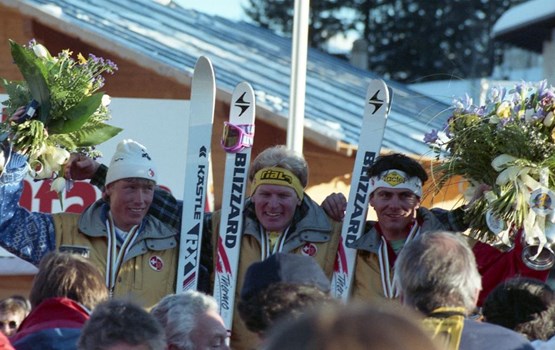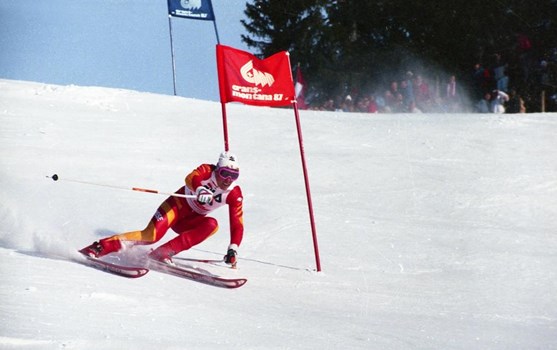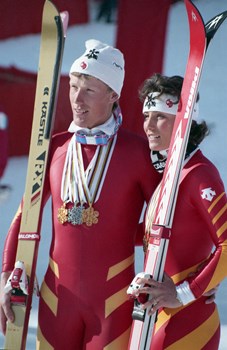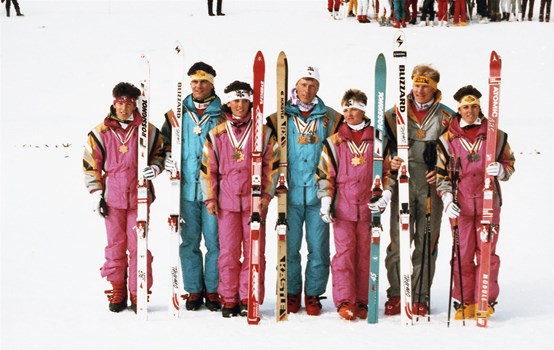30 YEARS AGO, A WORLD CHAMPIONSHIP OF SUPERLATIVES
The 29th edition of the FIS World Championships in 1987 was the most glorious one ever for Swiss Alpine Skiing. In front of their audience in Crans-Montana, Erika Hess, Vreni Schneider, Maria Walliser, Peter Müller and Pirmin Zurbriggen landed 14 podium places, taking eight gold medals, four silver and two bronze.
«The 1987 World Championships proved that we were on the right track in organising a competition like this. We formed an efficient association and organised effective management, as well as being lucky with the weather. We’re very happy with the result. » These were the words of the secretary general Guy Praplan, 47 years old at the time, at the end of the 1987 FIS World Championships.
Thirty years have passed. But Guy Praplan, a lawyer by profession, hasn’t changed his tune, and is perhaps even more enthusiastic. « When I hear the name Crans-Montana, and this happens to me when I’m in the train heading to the resort, I immediately see the World Championship logo again. The most intense emotion I experienced during the Worlds, one which overwhelmed me all of a sudden, was when I saw the crowd hurrying to the opening ceremony. We had at last achieved our first objective, and it was even more powerful to accomplish it in such a great atmosphere.» However it wasn’t just the opening which was a success, but the whole event. « A dream come true. The Worlds ran just as we had wanted them to, on a sporting level as well as with the festivities, and it all took place in wonderful sunshine », remembers the 1987 edition project manager.
STRONG OPPOSITION FROM ENVIRONMENTALISTS
The secretary general at the time remembers however that organising the Worlds was far from easy. Preparing the pistes was in itself an enormous challenge. Many trees had to be cut down, and although five hectares of forest were going to be replanted elsewhere, this led to opposition.The WWF, Greenpeace and other nature protection associations violently opposed the Worlds’ organisers. Guy Praplan had to go to the Federal Court to resolve the dispute. « Half of my time was taken up by this fight against different ecology groups », he remembers. It was only on 19 March 1986, ten months prior to the start of the championships, that Guy Praplan won the case and was finally able to breathe freely. « Even today, I daren’t imagine what would have happened if we hadn’t won in the Federal Court », he adds.
Organising the Worlds between 27 January and 8 February 1987 cost around 17 million francs, or almost double that of the previous World Championships in Switzerland, in St-Moritz in 1974. However this also meant that 100 million francs would be invested into the different infrastructure in the Valais Haut-Plateau communes of Icogne, Chermignon, Montana, Randogne and Mollens. With this money, tourist installations in particular were overhauled. Hotels and cable cars were replaced or modernised, and Le Régent Congress Centre was built. Some 1,700 people were brought in to realise the various projects, not to mention the huge logistical effort required to welcome 600 athletes, 400 journalists and 270 photographers for the Worlds. The Organisation Committee and its Executive Committee – made up of Jean-Pierre Clivaz (president, 1994), Hubert Bonvin (1st vice-president), Bouby Rombaldi (2nd vice-president, 2016), Edouard Rey ( 2001), Vital Renggli ( 2006), Gérard Bonvin and the secretary general Guy Praplan – were highly praised for the organisation and management of these Worlds. And in the end, Crans-Montana 1987 came out better than its predecessors in Bormio and Schladming/Haus. Amongst the negative points, the problems linked to traffic were a source of irritation until the end of the event. The organisers also saw a few criticisms, notably concerning the increase in prices in the resort during the competition.
OBJECTIVE FIS WORLD CHAMPIONSHIPS 2025
After the success of 1987, a new generation rallied in 2008, aiming to host the FIS World Championships planned for 2025. The push came from Marius Robyr, who is surrounded by strong characters ready to succeed in this challenge. The first stage has been successfully completed: since 2016, Crans-Montana has become an annual stage on the FIS World Cup calendar, establishing itself among the classics on the ladie’s circuit. Guy Praplan supports the efforts that are being made, whilst advising the team in place to demonstrate modesty and patience. « You must stay humble, learn to avoid difficulties and invest yourself fully. It’s rare to win on a first attempt, so that demands qualities such as perseverence », he warns.
FIS WORLD CHAMPIONSHIPS IN SWITZERLAND AND FOR THE SWISS
In 1987, Crans-Montana already had high quality pistes, which were technically very demanding. These pistes, the « Nationale » and« Mont Lachaux », both share the same finish area, and have also been redesigned thanks to the efforts of the Haut-Plateau councils, the ski lift company and the Casino foundation, in order to host the world skiing elite once again. It is on these pistes, and under a sun that shines almost constantly, that the Swiss delegation enjoyed their success at the 1987 Worlds. Led by Maria Walliser and Pirmin Zurbriggen, then in the lead in the general World Cup ranking, local skiers won eight out of the ten races on the programme on the Haut-Plateau. This outrageous domination did however bring some inconvenience, that is, to reduce the interest of foreign countries in these Worlds. For Guy Praplan however, it is wrong to think that Swiss supremacy had been a problem. « The Swiss dominating do not make for negative publicity. We are in Switzerland, and most of our guests are Swiss. Thanks to the triumph of the Helvetic ski racers, Crans-Montana will always have a place apart in the history of the Worlds.»
EIGHT GOLD MEDALS
It’s true that noone has forgotten this record edition. No team has dominated the event at home to the degree of the Swiss in 1987, with 14 medals of the 30 up for grabs. Erika Hess, Maria Walliser and Pirmin Zurbriggen each managed two world titles, whereas Peter Müller and Vreni Schneider also earned a gold medal.
It was Erika Hess who launched the Helvetic tidal wave, winning the Combined on 30 January, ahead of the Austrian Sylvia Eder and the American Tamara McKinney. 25 years old at the time, Erika Hess won this event, finishing 3rd in the Downhill – behind Michela Figini and Eder -, although she was already 3rd the day before in slalom – behind McKinney and Vreni Schneider. Eight days after her intial victory, Erika Hess would find herself on top of the podium again, in the Slalom this time. After a fabulous heat, she managed to transform a run of 1’’33 into an advance of 25 hundredths over Roswitha Steiner.
Before Erika Hess ended the Worlds in style, it was Maria Walliser who had hung on to the top place in the ladies’ heats. At just 23 years old, the skier from Toggenburg managed to win three medals in five days. On 1st February, she won the Downhill, ahead of her teammate Michela Figini and the German Regine Mösenlechner. Two days later, she doubled her winnings in the Super-G , again ahead of Figini and the Yugoslav Mateja Svet. However she missed the hat trick on 5 February in the Giant due to a big mistake in an early heat, so she had to be satisfied with a bronze medal.
As for the men, Pirmin Zurbriggen was a figure who stood out during these Worlds. He may have been beaten in the Downhill by his teammate Peter Müller, and in the Combined by Luxembourg’s Marc Girardelli, but the Valaisan wouldn’t let anyone outdo him in the Super-G, where he triumphed on 2 February, ahead of Girardelli and Markus Wasmeier. Two days later, the day of his 24th birthday, he won the Giant ahead of Girardelli and Alberto Tomba.
The climax of these FIS World Championships remains however the 31 January, the date of the Men’s Downhill. On that day, in front of 25,000 euphoric spectators, the men trained by Karl Frehsner managed to take the six first places. It was Peter Müller who took the main prize, in front of Pirmin Zurbriggen (2nd), Karl Alpiger (3rd), Franz Heinzer (4th) and Daniel Mahrer (6th).
The eighth and last gold medal for the Swiss came from Vreni Schneider. Still very young at the time, (22 ), the Glarus skier was crowned for the Giant, ahead of Mateja Svet and Maria Walliser, who had already been very close to a first medal in the Combined (4th place).
Thirteen years after the turmoil on home turf in St-Moritz, where only Lise-Marie Morerod managed a bronze medal on the last day, the Swiss left nothing but crumbs for their rivals in Crans-Montana. Only two titles escaped them, the Combined, won by Marc Girardelli, and the Slalom won by the German Frank Wörndl. Despite this bounty, these Worlds left a few Swiss skiers with regrets, for example, those who remained in the shadow of their team mates. This was for example the case for
Martin Hangl, Brigitte Oertli, Michela Figini (despite two silver medals), Corinne Schmidhauser and Franz Heinzer. However the most unhappy Swiss in 1987 had to be Joël Gaspoz. The Valaisan had almost won the race in the Giant before he fell a few gates from the finish line, losing the title to Pirmin Zurbriggen. - Original text in German by Beat Caspar. Translation into English by Sarah Dunn
DEPREZphoto SA, Crans
